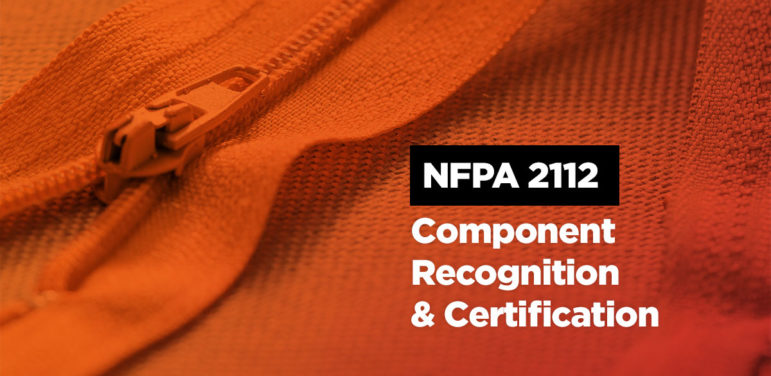You may have heard about the Component recognition or wondered about supplying or purchasing certified components compliant to NFPA 2112. There could be circumstances when there is confusion or no clarity on how to go about with these requirements.
In this first part of the blog, we will try to cover some common questions regarding the components and certification, as per NFPA 2112 and would try to answer the same to bring in clarity.
Q: What does Component Certification mean? What about Component Recognition? What is the difference?
For NFPA 2112, components refer to all materials, trims and accessories used to produce a garment, example – Fabric, Zippers, Buttons, Reflective tapes, Sewing thread etc. Component certification may be obtained by the manufacturer or supplier of a specific product. For example, 100% FR Cotton fabric quality # TS001, being manufactured by ABC Company, may be submitted to an ISO 17065 accredited certification body like UL or SEI for testing and certification for all relevant tests as defined in the NFPA 2112 standard. Once this component / fabric has been tested and certified, component recognition kicks in for the garment manufacturer who can opt to use this certified component for their garment certification program under NFPA 2112. This means that the garment manufacturer does not need to retest the component/fabric again in their name and the garment certification program will recognize the test certificate issued to ABC Company for style TS001. When ABC Company sells their fabric to the garment manufacturer, they are selling a component that has already been certified ahead of time. This also means that ABC Company owns the data for this certified component – the fabric and they can provide this certification to as many garment manufacturers they want to sell this fabric to.
However, there is one small catch: if you are a component supplier, you may want to make sure the data will be accepted by the garment manufacturer’s certification body, if the garment manufacturer plans to ask their certification body to recognize your certified component. Not all certification bodies accept data from one another. Garment manufacturers have the freedom to choose the certification body that works best for them from a time, cost and relationship perspective.
Q: How can I tell if the components I want to use to make my garments is NFPA 2112 Certified?
 Your component supplier should be able to tell you if they have gone through the certification process with a certifying body and the ISO 17065 body’s component mark, like the one given on the left would be on the product. The materials you purchase and the level of its testing and certification, is always as agreed between you and your supplier. Maybe you would prefer to use components that are pre-certified so that your garment certification is simpler and less expensive. Else, you could do testing on the components to check that it complies to the NFPA 2112 requirements at the time of purchase. And thereafter you would prefer to have the component officially tested and certified with your own garment so that you can own the test data.
Your component supplier should be able to tell you if they have gone through the certification process with a certifying body and the ISO 17065 body’s component mark, like the one given on the left would be on the product. The materials you purchase and the level of its testing and certification, is always as agreed between you and your supplier. Maybe you would prefer to use components that are pre-certified so that your garment certification is simpler and less expensive. Else, you could do testing on the components to check that it complies to the NFPA 2112 requirements at the time of purchase. And thereafter you would prefer to have the component officially tested and certified with your own garment so that you can own the test data.
If you are looking for a pre-certified component and you want to verify its certification – it’s not just tested but certified as well in accordance with the requirements of NFPA 2112, you can check the online directory available on the official websites of ISO 17065 certified bodies UL & SEI.
Q: I have a third-party test report saying my fabric complies with NFPA 2112 — is this good enough to call my garment compliant?
No, it is not. The fabric test report from any lab can only tell you that it is likely to pass the testing, when performed at the direction of the certification body. So, both components and garment must be certified, which will include not only the product testings but also audits by the certifying labs at the garment manufacturer’s production unit as per the directives of the NFPA 2112 standard.
As mentioned in the above question, the components like fabrics, zippers, etc. can be certified either by the component suppliers or by the garment manufacturer. If the fabric or other components are pre-certified, the process is simplified for the garment manufacturer as the components can be recognized towards certification. However, certification at the garment level must also be achieved to mark the garment NFPA 2112 certified.
Q: I need to get my garments certified to NFPA 2112. The component has already been certified and the certificate was provided by the supplier. I also double checked the online directory for the certifying labs and found the product listed as proof. Do I have to test it again?
Here again it is important to know that not all certification bodies will recognize each other’s components or certification data. So, it completely depends on where the component was certified and if your garment certification body will recognize components and accept data from other certification bodies. While the component if certified once should not theoretically need to be retested by the garment manufacturer, the reality is that due to non-acceptability, it might have.
For any further clarity, you can get in touch with our team.


Leave a Reply